判断“this 指向谁”是个老大难的问题。
网络上有许多文章教我们如何判别,但大多艰涩复杂,难以理解。
那么这里介绍一个非常简单实用的判别规则:
1)在函数【调用】时,“this”总是指向小数点左侧的那个对象
2)如果没有小数点,那么“this”指向全局作用域(比如 Window,严格模式为 undefined)
3)有几个可以改变“this”指向的函数——bind,call 和 apply
4)关键字 “new” 将 “this” 绑定到那个新创建的对象上
好了,我们已经学会了基本的理论知识,是时候运用一波了。请判断下面的 this 指向:
var foo = {bar: function () {return this}}
var b = foo.bar
foo.bar();
b();
var c = new someFunction();
相信你已经完全掌握了,下面我们再进行一点巩固练习:
(f = foo.bar)();
(1, foo.bar)();
(foo.bar)();

并不是上面的判别规则除了差错,而是新增的操作符/运算符增加了代码复杂度。为了解释上述代码的行为,我们需要理解 Reference 和 函数调用。
Reference Specification Type
在 ES5 中,除了基本的 6 种类型(string,number,boolearn,null,undefined,object),还有 reference 类型,不过它对使用者屏蔽,作为开发者,我们也不用关心它。
但是,了解它能够提升我们对 ECMAScript 的认识。
Reference 是什么
ECMAScript 将 Reference 定义为“被解析的命名绑定(resolved name binding)”,它由三部分组成——base,name, and strict flag。
有两种创建 Reference 的途径:
- 标识符解析
- 属性访问
比如,foo 和 foo.bar 创建了一个 Reference ,而字面量(1,“foo”,[1,3]等)或函数表达式——(function(){})却不会。
参考下图:

每创建一个 Reference 都会为其对应的 base,name,strict 设置相应的值。"strict "对应代码是否开启了严格模式;"name"设置为标识符或属性名;"base"设置为 property 对象或环境记录(environment record)。
可以认为 Reference 是一个不带原型、有且只有 3 个属性的对象。譬如说:
'use strict';
var foo;
// 标识符解析会产生 Reference
var Reference = Object.create(null);
Reference.base = EnvironmentRecord;
Reference.name = 'foo';
Reference.strict = true;
// or
foo.bar;
// 属性访问会产生 Reference
var Reference = Object.create(null);
Reference.base = foo;
Reference.name = 'bar';
Reference.strict = true;
// or 使用未声明的变量
a;
var Reference = Object.create(null);
Reference.base = undefined;
Reference.name = 'a';
Reference.strict = true;
函数调用
当函数调用的时候,会发生什么?Function Calls
1. Let ref be the result of evaluating MemberExpression.
2. Let func be GetValue(ref).
3. Let argList be the result of evaluating Arguments, producing an internal list of argument values ([see 11.2.4](https://es5.github.io/#x11.2.4)).
4. If Type(func) is not Object, throw a TypeError exception.
5. If IsCallable(func) is false, throw a TypeError exception.
6. If Type(ref) is Reference, then
* If IsPropertyReference(ref) is true, then Let thisValue be GetBase(ref).
* Else, the base of ref is an Environment Record, Let thisValue be the result of calling the ImplicitThisValue concrete method of GetBase(ref).
7. Else, Type(ref) is not Reference.
* Let thisValue be undefined.
8. Return the result of calling the *Call* internal method on func, providing thisValue as the this value and providing the list argList as the argument values.
ES5 标准告诉我们一个事实——只有在函数真正调用的时候,才能判断 this 的值。
赋值,逗号和分组操作符
有了以上的准备,我们可以解答(f = foo.bar)()、(1, foo.bar)()和(foo.bar)()的 this 指向问题了。
简单赋值(=)操作
诸如 a = 1, g = function(){} 等都属于Simple Assignment,和函数调用一样,在赋值发生之前,JS 也会做一些准备工作:
- Let lref be the result of evaluating LeftHandSideExpression.
- Let rref be the result of evaluating AssignmentExpression.
- Let rval be GetValue(rref).
- Throw a SyntaxError exception if the following conditions are all true:
a. Type(lref) is Reference is true
b. IsStrictReference(lref) is true
c. Type(GetBase(lref)) is Environment Record
d. GetReferencedName(lref) is either "eval" or "arguments"- Call PutValue(lref, rval).
- Return rval.
注意,在赋值前,等号右侧的表达式的值会经过内部函数 GetValue 进行转化。
在我们的例子中,GetValue 将 foo.bar 的引用转化成那个实际的函数。赋值完成后,和调用(function(){})()没有什么分别。现在我们可以使用前面定义的规则来判别 this 指向了,显然这符合第二条规则—— this 指向全局。
逗号操作符
上面的过程也适用于逗号操作符 Comma Operator ( , )
- Let lref be the result of evaluating Expression.
- Call GetValue(lref).
- Let rref be the result of evaluating AssignmentExpression.
- Return GetValue(rref).
GetValue 将 foo.bar 的引用转化成那个实际的函数。逗号操作符计算完成后,和调用(function(){})()没有什么分别。
分组操作符
Grouping Operator会使用 GetValue 计算表达式吗?
Return the result of evaluating Expression. This may be of type Reference.
This algorithm does not apply GetValue to the result of evaluating Expression.
由于分组操作符不会对表达式做额外的操作,所以(foo.bar)() 和 foo.bar()没有差别,this 指向 foo。
(完)
如果你想知道更多细节,不妨点击Annotated ECMAScript 5.1。
虽然不是标准文档,但更容易阅读。